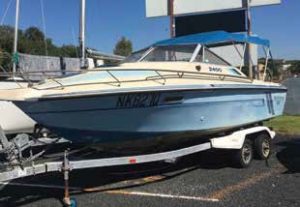NANNI’s Queensland distributor completed a restoration of a 1986 Mustang 24’ as a demonstrator for their engines. They were trying to demonstrate in a practical way that an older petrol driven vessel could be converted to diesel.
Traditionally, most vessels of this type in the Australian market were powered by V8 petrol sterndrives or two stroke outboards. Most new vessels and repowers of this kind are now installed with large 4 stroke outboards. The following is what was proven in the restoration.
1. That a modern Nanni diesel engine will fit the same size and weight envelope and provide the same or better performance than a V8 petrol engine. It was direct bolted so it would fit the transom, beds and connection points of a V8 Mercruiser. Performance improvements focussed on low end torque and improved hole shot. Improvement was also made for rough weather operations at low to medium speeds.
2. Much better fuel economy. Besides reduced operating costs, this means for a petrol repower, the vessel’s operating range is extended with the same size fuel tank. This is a double benefit because normally to extend the range, extra fuel must be carried which adds weight and increases fuel consumption.
3. Improved reliability and much longer service life with a proper heat exchange cooled NANNI diesel, compared to a seawater cooled petrol engine. Typically, only commercial operators were heavily focussed on engine longevity, however many pleasure vessel owners are coming to realise that the maintenance on inboard petrol engines can be very expensive as they age due to corrosion etc.
4. Fuel safety. This speaks for itself compared to carrying petrol inside any vessel. Most oil and gas companies, defence forces and fleet commercial operators, now prohibit the use of any petrol fuelled engines.
5. The modern NANNI diesel engines are smooth and quiet providing a comparable environment to 4-stroke engines (not like old diesels)
6. Cost of petrol engines in these vessels was originally much less expensive than the diesels of the time. Modern 4-stroke outboards are getting quite expensive though and the NANNI distributor was wishing to show that their engines are a cost competitive option, even if the initial purchase price is a little higher. The much longer lifespan, reduced servicing and reduced fuel consumption, goes a long way to offsetting the extra cost.
7. The NANNI distributor chose the Mustang because it is typical of the many thousands of boats built in that era and are now nearing the end of their service life. They were wishing to demonstrate that rather than sending them to landfill, there is a more environmentally friendly option. Largely their hulls are still solid, so by installing a modern diesel which is fuel efficient and emissions compliant, they are reducing environmental impact on a number of fronts.
8. The NANNI diesel engines are compliant with the requirements of even the strictest countries around the world.
9. Reduced servicing lowers waste oils and filters being disposed of in the environment.
10. Now with modern connectivity NANNI engine data such as fuel consumption, throttle position, load percentage, low oil alarms etc, can be broadcast to on board marine electronics such as MFD’s (Multi-Function Displays).
To discuss new engine products or repowering an existing boat, contact Marine Diesel at www.marinediesel.net.au or phone: (07) 3390-3633
Published in print January-March 2024




























